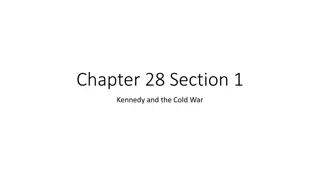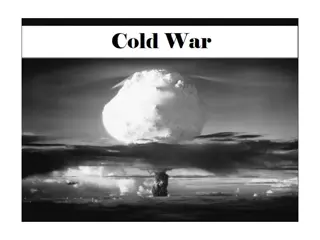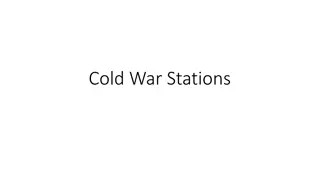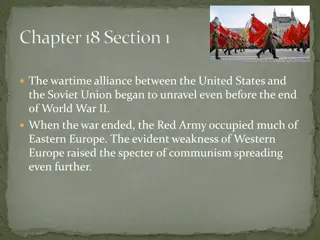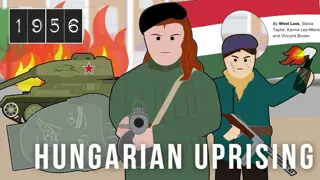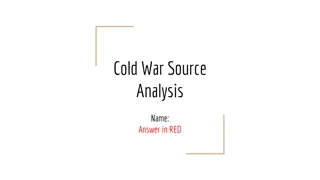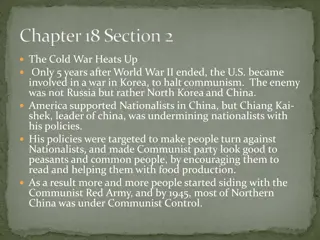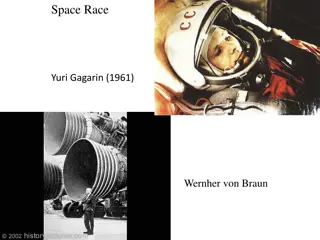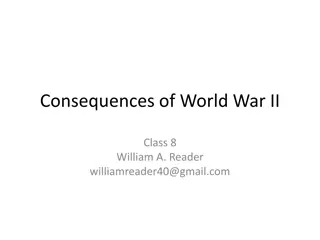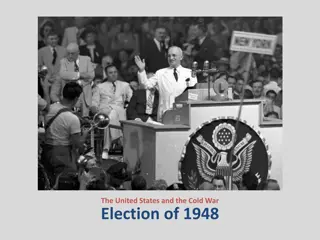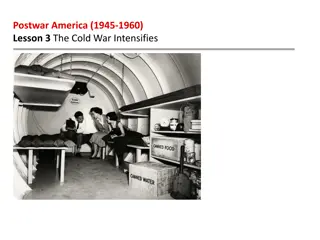Airpower Through the Cold War: A Historical Overview
This historical overview delves into the significance of airpower during the Cold War era, exploring key events such as the National Security Act of 1947, the Berlin Airlift, and the Cuban Missile Crisis. It outlines the establishment of the United States Air Force, the circumstances post-WWII, the Allied Occupation Zones, the Soviet blockade, the Allied response through the Airlift mission, and the results achieved, highlighting diplomatic, technological, and strategic aspects of airpower.
Download Presentation

Please find below an Image/Link to download the presentation.
The content on the website is provided AS IS for your information and personal use only. It may not be sold, licensed, or shared on other websites without obtaining consent from the author. Download presentation by click this link. If you encounter any issues during the download, it is possible that the publisher has removed the file from their server.
E N D
Presentation Transcript
Airpower Through the Cold War 1
Overview National Security Act of 1947 Berlin Airlift Curtis LeMay Korean Conflict Cuban Missile Crisis 2
National Security Act of 1947 Established the Department of Defense and created the Air Force Executive Order 9877 outlined the main functions of the Air Force The United States Air Force stood up on 18 September 1947 3
Circumstances after WWII Soviets intent on security of their borders Russia had been invaded twice Soviets suffered millions of casualties in the WWII invasion Allies were not seeking vengeance in Germany Allies wanted to revitalize and stabilize economy 4
Allied Occupation Zones Soviets given East Germany to include Berlin United States given southwest Germany Britain given northwest Germany Berlin then divided, and Allies, including France, each given a sector inside Berlin itself 5
Blockade Soviets refused to supply food Soviets allowed three air corridors Soviets demanded their currency (money) be adopted Soviets blockaded road, rail, and waterways Soviets cut off all power 6
Allied Response (United States) Airlift mission begins Backup of airlift through basing of strategic nuclear capability in England (36 B-29s deployed) 7
Airlift Begins 25 June 1948 C-47 (Skytrain) could fly 2 to 3 tons of cargo C-54 (Skymaster) could fly 10 tons of cargo 2 million tons of cargo in almost 277,000 flights 8 C-54 C-47
Results Diplomatic weapon Technological achievement Strength of airpower 10
General Curtis LeMay I don t mind being called tough, since I find in this racket it s the tough guys who lead the survivors. ~ Colonel Curtis E. LeMay, to Lt Gen Ira Eaker England, 1943 11
General Curtis LeMay Navigator on B-17 as lieutenant in early airpower demonstration with ocean liner Rex in 1938 Commanded units in Berlin airlift Commander in Chief, Strategic Air Command (CINCSAC) Air Force Chief of Staff 13
LeMays Impact on the Air Force More realistic training programs Bottom line discipline Procured personnel and aircraft Bombers became airborne nuclear alert Nuclear deterrence became a reality 14
Korean Conflict National Security Council (NSC) directive 68 called for a massive increase in defense spending to contain Communism (April 1950) Korea was the first test of American resolve Korean War Service Medal 16
Beginning of Korean Conflict June 25, 1950, North Korea launched a surprise invasion of South Korea Congress approved use of force to repel North Korean invasion (no formal declaration of war) UN Security Council authorized aid (Gen Douglas McArthur named Commander) 17
Korean Conflict UN forces were saved at the Pusan perimeter by around the clock bombing and interdiction McArthur launched surprise amphibious assault at Inchon UN forces drove North Koreans back across 38th parallel and attempted to unify the country China entered, pushing the UN forces back 19
Airpower in Korean Conflict First use of jet fighters on both sides MiG-15 outperformed F-80 MiG-15 retreated back to bases in China Airspace south of Yalu river known as MiG Alley F-86 Sabre proved superior to the MiG-15 Kill ratio of 10-to-1 MIG-15 F-80 F-86 21
Airpower in Korean Conflict Contributions of airpower to the Korean conflict Counterland: Airpower operations conducted to attain and maintain a desired degree of superiority over surface operations by the destruction or neutralization of enemy surface forces Interdiction: Operations to divert, disrupt, delay, or destroy the enemy s surface military potential before it could be used effectively against friendly forces Close Air Support: Operations against hostile targets in proximity to friendly forces 22
Deterrence and Missile Development SNARK Atlas, Titan Minuteman became the mainstay of SAC s missile retaliatory force NORAD established in 1957 Single Integrated Operational Plan for using nuclear weapons (SIOP) 24
Cuban Missile Crisis Sept 1962 U-2 reconnaissance plane detailed Soviet missile launchers in Cuba US missile force placed on alert status President Kennedy chose option of naval quarantine Soviet Union backed down and the nuclear crisis was averted Doctrine of Flexible Response evolves 25
Summary National Security Act of 1947 Berlin Airlift Gen Curtis Lemay Korean Conflict Cuban Missile Crisis 26




